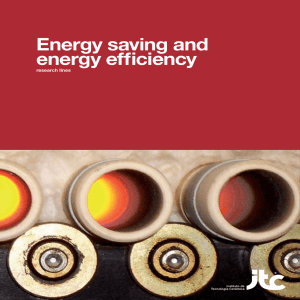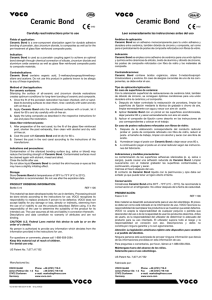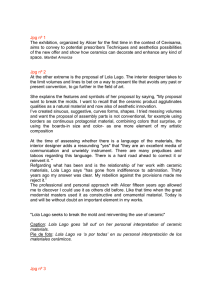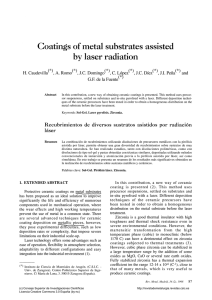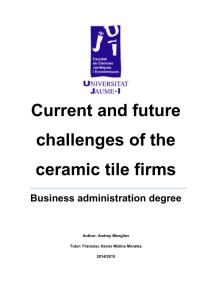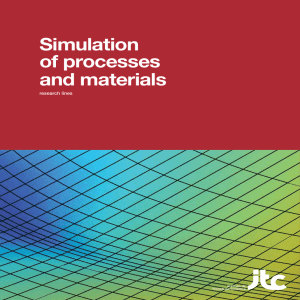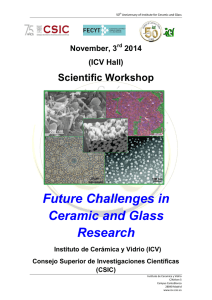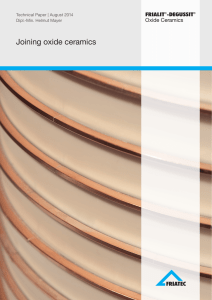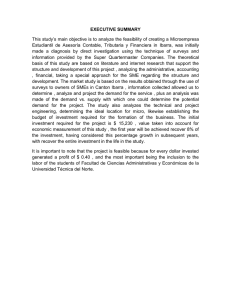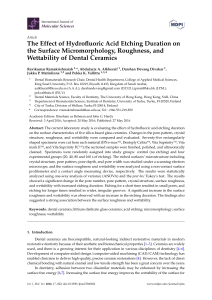energy saving and energy efficiency
Anuncio
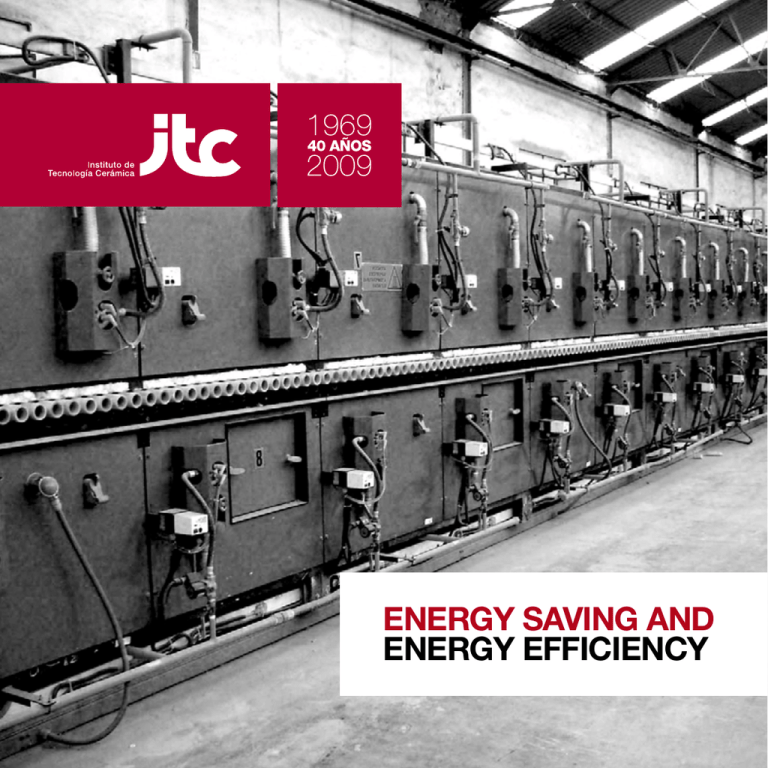
ENERGY SAVING AND ENERGY EFFICIENCY ENERGY SAVING AND ENERGY EFFICIENCY Since the outset, ITC has conducted R&D and technology consulting activities on energy issues in the ceramic and related industries. In 2006, given the sector’s growing interest in energy saving and energy efficiency, ITC set up a specific work group, the Energy Unit, devoted to this line of action. The Unit provides technological consulting on energy saving in the ceramic manufacturing process. In addition, the Unit is participating in the performance of R&D&I projects on the optimisation and diversification of energy consumption at the companies, as well as in customised training activities. ITC, in general, and the Energy Unit, in particular, are aware of the importance of energy saving in industry, not only with a view to enhancing company competitiveness but also to helping achieve certain common sustainable development and social commitment policies. 2 The Instituto de Tecnología Cerámica (ITC) is a concerted mixed Institute, established by agreement between the Ceramic Industry Research Association (AICE) and Universitat Jaume I of Castellón, which originated in 1969 in response to the needs of companies from the Spanish ceramic cluster. In its long track record, ITC has articulated a successful university–business cooperation system that has contributed significantly to the development of the Spanish ceramic tile manufacturing industry. ITC’s mission is to provide solid support for Spanish ceramic companies in the defence and enhancement of their strategic positioning in the current global context, principally through innovation-enabling research and development actions, but also through whatever activities may serve to foster the competitiveness and growth of the sector, always based on sustainability criteria and commitment to the well-being of society. ITC’s vision is focused on spearheading technology innovation and design processes in the Spanish ceramic sector, anticipating market and consumer needs regarding the uses and applications of ceramic materials, through professionalised management of a qualified human team committed to excellence in the sector. The Unit’s energy-saving and energy-efficiency services include the following: • Performance of energy audits • Studies of energy reuse or recovery in industrial plants • In a facility: kilns, dryers, spray dryers • Between facilities: heat recovery • Optimisation of energy consumption in industrial kilns • Customised training The manufacture of ceramic products such as ceramic tiles or structural ceramics (roofing tiles and bricks) requires a great quantity of thermal energy. Ascertaining which energy-saving actions could be implemented in the manufacturing process, in order to optimise energy consumption and enhance overall energy efficiency, is of vital interest to ceramics manufacturers. 3 In this regard, some of the tests conducted to study the particular situation of each facility are briefly summarised below: • Determination of industrial firing cycles • Determination of static pressure curves in industrial kilns • Determination of oxygen partial pressure curves in industrial kilns • Measurement of transverse temperature gradients in single-deck roller kilns • Analysis of excess air at the burners • Determination of drying curves in industrial dryers • Measurement of relative humidity in industrial dryers • Measurement of gas stream flow rates • Energy balances of industrial facilities: spray dryers, ceramic tile dryers and kilns, dryers and tunnel kilns for ceramic ware • Analysis of heat losses by thermographic images In addition, the Energy Unit is participating in R&D activities searching for alternatives to the use of natural gas, a fuel of fossil origin, in the ceramic manufacturing process in order thus to reduce the industry’s environmental impact. The work being conducted includes: • Analysis of the use of hydrogen in the ceramic tile manufacturing process • Study of the application of current CO2 capture and storage techniques in the ceramic sector At present, the Energy Unit is participating in the Spanish Hydrogen and Fuel Cell Technology Platform (PTE-HPC), and is currently entering the Spanish Energy Efficiency Technology Platform (PTE-EE). 4 AVAILABLE EQUIPMENT • • • • Discontinuous analyser of combustion gases (O2, CO, NOx, SO2) On-line CO2 measurement system Gas flow rate measurement equipment: Pitot tubes, thermocouples, pressure gauges Thermographic chamber for the obtainment of thermographs and non-contact determination of surface temperature • Capacitive hygrometer for the determination of moisture content in gas streams • Device for on-line temperature measurement inside the dryer 5 R&D PROJECTS COFINANCED WITH PUBLIC FUNDING Central Government of Spain Published articles FIT-120000-2006-1 – Reduction of corporate energy costs using cogeneration by hydrogen generation (2006-2007) Cantavella, V.; Moreno, A.; Mezquita, A.; Llorens, D.; Barberá, J.; Palanques, A. Distribución de temperaturas en el interior de una pieza durante la cocción industrial. Cerámica Información, 331, 61-68, 2006. REN2003-09247-C04-04 - Application of solar energy in ceramic materials processing (2000-2003). Autonomous Government of Valencia IMIDIC/2007/117 – Environmental Sustainability in the ceramic industry (2007-2008) IMDITE/2007/13 - Competitive Intelligence System: Energy and Environment Observatory (2008) Mallol, G.; Mezquita, A.; Llorens, D.; Jarque, J.C.; Sahún, J.; Valle, F. Estudio de la operación de secado de los soportes de las baldosas cerámicas en secaderos verticales. Técnica Cerámica, 304, 805-817, 2002. Enrique, J.E.; Mallol, G.; Monfort, E.; Cantavella, V. Racionalización de energía en hornos de cocción de baldosas cerámicas. Cerámica y cristal, 124, 21-32, 1998. Moreno, A; Mallol, G.; Llorens, D.; Enrique, J.E.; Ferrer, C.; Portolés, J. Estudio de los gradientes transversales de temperatura en un horno monoestrato en diferentes condiciones de operación. Cerámica Información, 229, 29-36, 1997. Ferrando, F.; Llorens, D.;Enrique, J.E.; Moreno, A.; Negre, P. Desarrollo de un equipo para la determinación de la distribución de temperaturas en el interior de secaderos de baldosas. Técnica Cerámica, 244, 418-420, 1996. Jarque, J.C.; Moreno, A.; Enrique, J.E.; Barba, A. Optimización de las condiciones de funcionamiento en hornos monoestrato (IV). Mecanismos de transmisión de energía calorífica. Técnica Cerámica, 247, 566-572, 1996. Enrique, J.E.; Mallol, G.; Páramo, M.; Salvá, E. Influencia de la evolución tecnológica sobre el consumo energético en la fabricación de baldosas cerámicas. Cerámica Información, 222, 3-12, 1996. Enrique, J.E.; Blasco, A.; Monfort, E.; Mallol, G. Improving energy efficiency in singledeck kilns by optimization of the process variables. cfi/Ber. DKG, 72(5), 255-260, 1995. 6 Ferrer, C.; Llorens, D.; Mallol, G.; Monfort, E.; Moreno, A. Optimización de las condiciones de funcionamiento en hornos monoestrato (III). Medida de gradientes transversales de temperatura. Técnica Cerámica, 227, 653-662, 1994. Blasco, A.; Enrique, J.E.; Mallol, G.; Monfort, E. Optimización de las condiciones de funcionamiento en hornos monoestrato (II). Caudal de aire de combustión. Técnica Cerámica, 218, 716-729, 1993. Timellini, G.; Blasco, A. Energy Consumptions and carbon Dioxide Emissions in the Ceramic Tile Sector: Italy and Spain. Ceram. Acta, 5(1/2), 41-50, 1993 Blasco, A.; Carda, L.; Mallol, G.; Monfort, E. Optimización de las condiciones de funcionamiento en hornos monoestrato (I). Curva de presiones. Técnica Cerámica, 206, 585-593, 1992.
